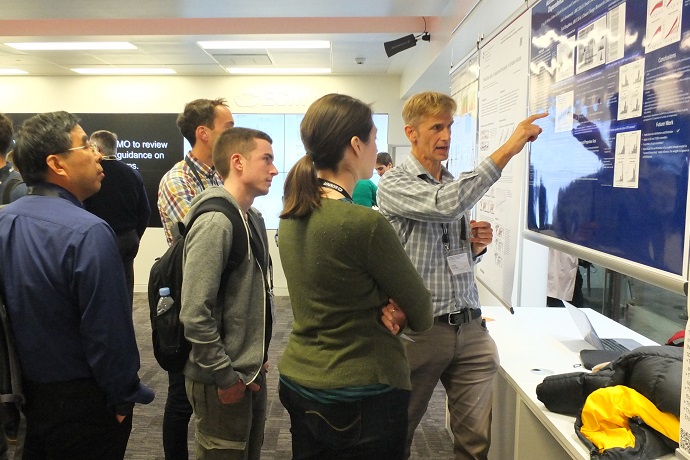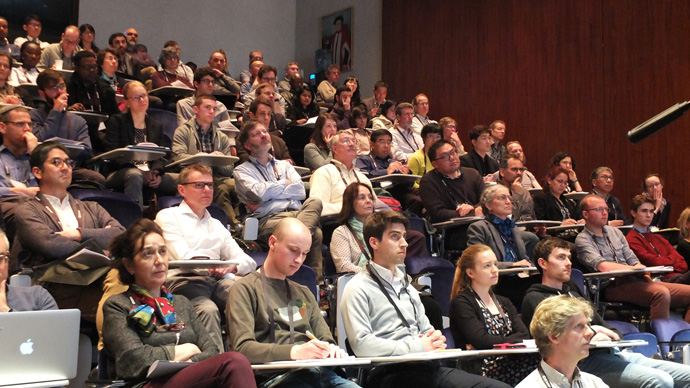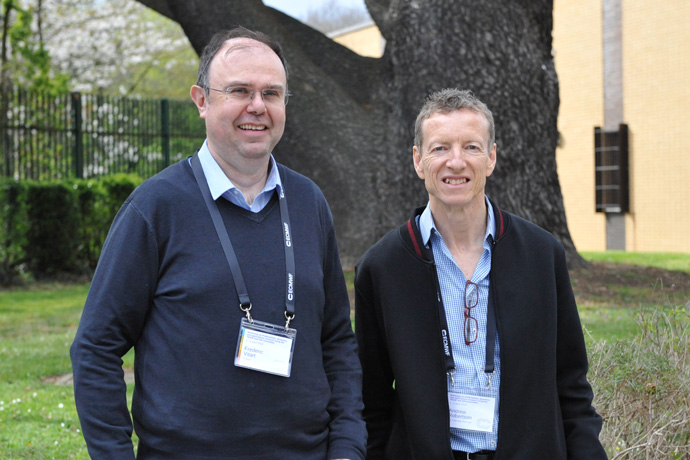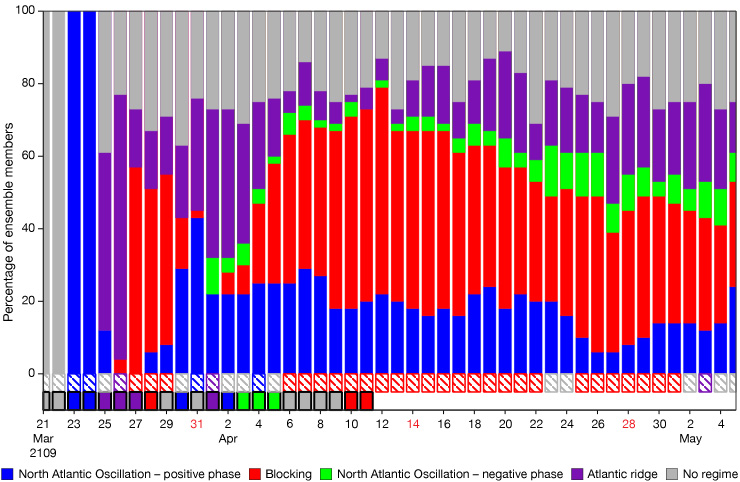

Many of the scientists brought posters along to explain their use of the TIGGE and S2S databases.
Scientists from across the world flocked to ECMWF from 2 to 5 April 2019 to discuss predictability, dynamics and applications research using the TIGGE and S2S ensemble forecast databases.
The TIGGE database was set up by the World Weather Research Programme in 2006. It comprises operational global medium-range ensemble forecasts from ten weather forecasting centres.
A similar database for forecasts up to 60 days ahead from 11 forecasting centres has also been created. It is one of the outcomes of the S2S Prediction Project launched in 2013 by the WMO as a collaborative project between the World Weather Research and World Climate Research Programmes.
The meeting attracted more than 100 external participants. It was of particular interest to ECMWF as the Centre is currently testing a range of new forecast products for the sub-seasonal range.
Purpose of the S2S Prediction Project
“The S2S project has a special emphasis on high-impact weather events, with a ready–set–go approach, developing coordination among operational centres,” says Estelle de Coning, Scientific Officer for the World Weather Research Programme at the WMO.
“It also aims to promote uptake of S2S products and information by the applications communities.”
She adds that one of the major outcomes of the first phase of the S2S project, from 2013 to 2018, was the establishment of the S2S database.
“Phase II of the project will enhance the S2S database as a backbone for S2S research and follow the entire value chain to also strengthen user applications and decision-making in sectors such as agriculture, health and energy.”

ECMWF’s lecture theatre was packed during the TIGGE/S2S workshop.
S2S Prediction Project forecasts are archived in full at ECMWF and the China Meteorological Administration and in part at the US International Research Institute for Climate and Society (IRI, Colombia University).
“At IRI we give users data analysis tools so they can work with the data without the need to download them,” says Andy Robertson, who gave a talk at the workshop and is the Head of the Climate Group at IRI.
Andy co-chairs the S2S Prediction Project jointly with ECMWF scientist Frédéric Vitart.
S2S forecast challenges
Medium-range forecasts up to 15 days ahead predict the weather by running a weather model forward in time based on a set of initial values.
Seasonal forecasts exploit the long-term predictability of boundary conditions, such as sea-surface temperatures. “This is used to predict deviations from normal conditions averaged over sufficiently long periods to filter out weather noise,” says Andy.
The forecast range between about two weeks and a couple of months ahead was long deemed to fall between the cracks.
“It was regarded as a predictability desert, too long to work as an initial value problem, and too short to work as a boundary value problem,” says Andy.
“It is only about 20 years ago that substantial progress started to be made, and since about 2010 an increasing number of forecasting centres have included S2S predictions in their output,” says Frédéric.
“One of the main reasons for these advances is that we have gained a better understanding of the sources of predictability, in particular the Madden–Julian Oscillation, a travelling pulse of cloud and rainfall near the equator,” he explains.

Frédéric Vitart (left) and Andy Robertson (right) jointly chair the S2S Prediction project.
The result is that, according to a recent paper by Andy and Frédéric published in the Nature Research journal Climate and Atmospheric Science, there is now evidence that “S2S forecasts have the potential to predict the onset, evolution and decay of some large-scale extreme events several weeks ahead”.
Test products
In this spirit, and in line with its long-term Strategy, ECMWF has recently developed some test products designed to support the prediction of severe weather in Europe at the sub-seasonal time range.
“The basic idea is to identify the main weather regimes in the Euro-Atlantic region and to predict the probability that future weather will be dominated by one or another of these patterns,” says ECMWF scientist Laura Ferranti, who led the project.
“This can provide insights into the likelihood of severe weather events often associated with particular weather regimes, such as cold spells.”

The chart shows the percentage of ensemble forecast members that predict different types of weather regimes for the European domain. In this case, the forecast starting on 21 March 2019 predicted a growing probability of a ‘blocking’ weather regime from early April, which in fact came to pass on 10 April, according to the verification shown in the small columns at the bottom of the chart. The hatched bars represent the ensemble mean regime attribution.
Test products have been developed for the likelihood of regime transitions associated with the occurrence of severe cold spells, and for the probabilities of occurrence of sudden stratospheric warmings and weather regimes.
“First evaluation results are promising,” Laura says. “We are inviting ECMWF forecast users to test these products and let us have their feedback.”
Further information
The presentations and recordings of the TIGGE/S2S workshop are available on the workshop web page.
More information on the test products can be found on the ECMWF test product page (access to the test products is limited to forecast users with the right credentials).
Details about a new ECMWF product to flag up the risk of cold spells weeks ahead can be found in an article by Laura Ferranti in the winter 2018/19 issue of the ECMWF Newsletter.
